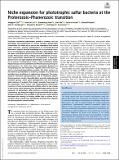Notice
This is not the latest version of this item. The latest version can be found at:https://dspace.mit.edu/handle/1721.1/133841.2
Niche expansion for phototrophic sulfur bacteria at the Proterozoic–Phanerozoic transition
Author(s)
Cui, Xingqian; Liu, Xiao-Lei; Shen, Gaozhong; Ma, Jian; Husain, Fatima; Rocher, Donald; Zumberge, John E; Bryant, Donald A; Summons, Roger E; ... Show more Show less
DownloadPublished version (1.257Mb)
Publisher Policy
Publisher Policy
Article is made available in accordance with the publisher's policy and may be subject to US copyright law. Please refer to the publisher's site for terms of use.
Terms of use
Metadata
Show full item recordAbstract
© 2020 National Academy of Sciences. All rights reserved. Fossilized carotenoid hydrocarbons provide a window into the physiology and biochemistry of ancient microbial phototrophic communities for which only a sparse and incomplete fossil record exists. However, accurate interpretation of carotenoid-derived biomarkers requires detailed knowledge of the carotenoid inventories of contemporary phototrophs and their physiologies. Here we report two distinct patterns of fossilized C40 diaromatic carotenoids. Phanerozoic marine settings show distributions of diaromatic hydrocarbons dominated by isorenieratane, a biomarker derived from low-light-adapted phototrophic green sulfur bacteria. In contrast, isorenieratane is only a minor constituent within Neoproterozoic marine sediments and Phanerozoic lacustrine paleoenvironments, for which the major compounds detected are renierapurpurane and renieratane, together with some novel C39 and C38 carotenoid degradation products. This latter pattern can be traced to cyanobacteria as shown by analyses of cultured taxa and laboratory simulations of sedimentary diagenesis. The cyanobacterial carotenoid synechoxanthin, and its immediate biosynthetic precursors, contain thermally labile, aromatic carboxylic-acid functional groups, which upon hydrogenation and mild heating yield mixtures of products that closely resemble those found in the Proterozoic fossil record. The Neoproterozoic–Phanerozoic transition in fossil carotenoid patterns likely reflects a step change in the surface sulfur inventory that afforded opportunities for the expansion of phototropic sulfur bacteria in marine ecosystems. Furthermore, this expansion might have also coincided with a major change in physiology. One possibility is that the green sulfur bacteria developed the capacity to oxidize sulfide fully to sulfate, an innovation which would have significantly increased their capacity for photosynthetic carbon fixation.
Date issued
2020Journal
Proceedings of the National Academy of Sciences of the United States of America
Publisher
Proceedings of the National Academy of Sciences